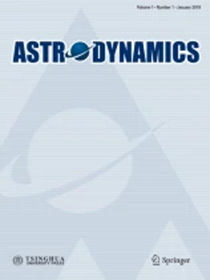Debris falling forecast method for spacecraft disintegrating separation
Abstract
Large spacecraft fall out of orbit and re-enter the atmosphere at the end of their lifetime, and they can break up into small debris upon re-entry. The spacecraft debris generated by the disintegration may lead to high risk when the surviving debris reaches the ground. One way to reduce the damage risk of spacecraft is to simulate the spacecraft disintegration process and accurately predict the falling area. Aerodynamics seriously affects the reentering process, especially in the continuous flow regime. Aerodynamic force and heat are the main factors leading to debris disintegration. High dynamic pressure leads to sharp changes in attitude and complex trajectories during debris fall. A numerical method based on an unstructured Cartesian grid was developed to simulate the disintegrating separation problem by coupling the Navier-Stokes equation and the six-degree-of-freedom trajectory equation. A method combining the numerical method for dynamic processes with numerical simulation based on a static aerodynamic/dynamic characteristic database was developed for forecasting the falling area. Spacecraft disintegrating separation from 60 km was simulated using the method, and the multibody aerodynamic interference and the separation trajectory were predicted. The falling process was forecast by a numerical simulation method based on the static aerodynamic database/dynamic characteristic database when the debris went out of the influence domain. This method has good forecasting efficiency while considering the aerodynamic interference, making it a valuable method for forecasting disintegrating separation and falling debris.

 求助内容:
求助内容: 应助结果提醒方式:
应助结果提醒方式:


